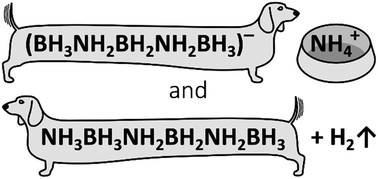Abstract
Attempts of the synthesis of ionic (NH4)(BH3NH2BH2NH2BH3) via a metathetical approach resulted in a mixture of the target compound and partly dehydrogenated molecular NH3BH2NH2BH2NH2BH3 product. The mixed specimen was characterised by NMR and vibrational spectroscopies, and the cocrystal structure was analyzed from powder X-ray diffraction data supported by theoretical density functional theory calculations. The compound crystallises in a P21/c unit cell with the lattice parameters of a = 13.401(11) Å, b = 13.196(8) Å, c = 17.828(12) Å, β = 128.83(4)°, V = 2556(3) Å3 and Z = 16. Despite their impressive hydrogen content, similar to ammonia borane, both title compounds release hydrogen substantially polluted with borazine and traces of ammonia and diborane.



 Please wait while we load your content...
Please wait while we load your content...